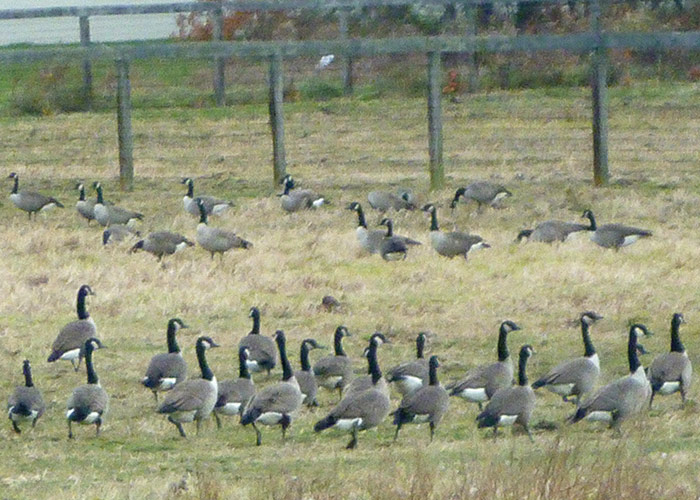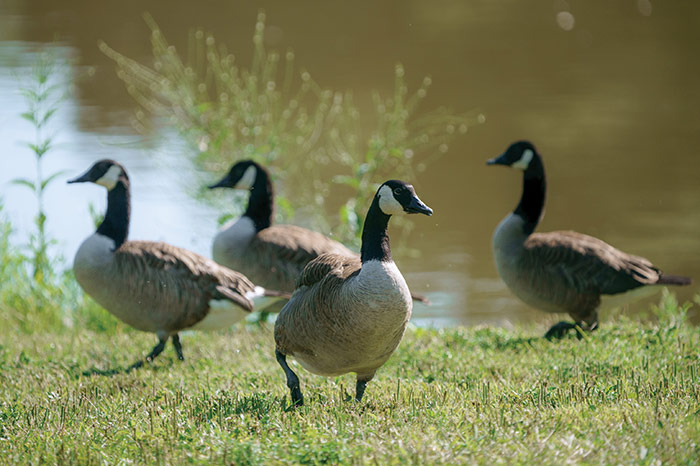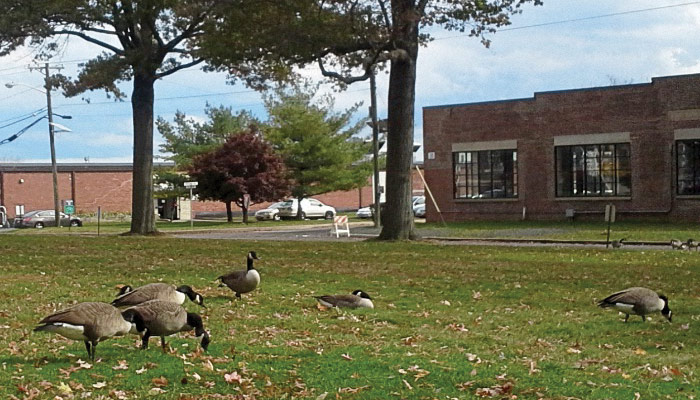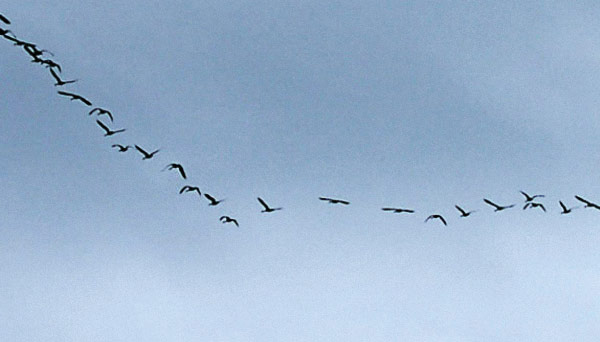Canada Geese: The Bird Control Challenge of the Decade
 |
|
Numerous Canada geese taking over the Rutgers University agriculture fields. Photo: M. Anderson, U.S. EPA |
By Marcia Anderson, PhD, U.S. EPA
When summer is here, so are the geese. Are Canada geese a problem in your neighborhood, farm, park, or ball field?
We know that Canada geese readily adapt to habitats in urban and suburban areas. Although a few geese may be desirable in a park, pond, or back yard, a small gaggle can increase rapidly and become difficult to manage. According to numerous state agencies and the Federal Aviation Administration, geese also pose some of the greatest bird-control challenges of this decade.
The Trouble with Geese
Geese are a nuisance due to the accumulation of their droppings and feathers, their trampling and overgrazing of grass (which creates large dead spots), and their aggressive behavior and noise.
At times, they can represent a serious risk to human health and safety. Heavy concentrations of goose droppings also contain a large amount of nitrogen, which can lead to excessive algal growth and reduced water quality in ponds and lakes.
Keys to Successful Management
While there’s no one-size-fits-all solution that can be used universally to reduce environmental and human/goose conflicts, an integrated pest management (IPM) approach that uses several techniques in combination can help successfully manage Canada geese.
Identifying the site characteristics that are most attractive to the geese—and altering that habitat—is a good first step.
Geese are a nuisance, and at times, they can represent a serious risk to human health and safety.
Most sites with goose problems are characterized by a large, unobstructed lawn next to a body of water; this can include parks, golf courses, planned residential communities, and more. These areas provide geese with everything they need to thrive: access to food, water, and an avenue of escape from predators, creating a goose paradise.
Strategies to manage these geese can include some or all of the following.
 |
|
Geese along an unobstructed waterfront. Photo: John Brighenti, flic.kr/p/2maCmu9, CC BY 2.0 |
Modifying Habitats to Make Them Less Goose Friendly
An effective solution for reducing geese in these areas is to modify the habitat by reducing the lawn or adding impediments at the shoreline.
If fields must be near the water’s edge, creating vegetative barriers such as shrubs or hedges can obstruct the geese’s line of sight. This is important for two reasons: it makes the area less attractive because of the potential for attack from predators, and it blocks their preferred pathways to and from the water by shortening/obscuring their flight-landing runway.
Fence barriers can prevent geese from walking from water to grazing areas. Regardless of the fencing material, openings should be no larger than three inches by three inches wide and the fence should be at least three feet tall. It should be long enough to discourage the geese from walking around the ends.
Most sites with goose problems are characterized by a large, unobstructed lawn next to a body of water.
Plants should also be at least three feet tall to prevent adult geese from seeing over them, and dense enough to prevent the geese from walking through them.
The shrubs can be intermittently planted with tall grasses or wildflowers for visual effect. These also help to fill in planting gaps where young shrubs are still maturing. Tall trees with a dense canopy may also prevent geese from landing if located in the flight paths between water and grassy areas.
Adding boulders—at least two feet in diameter—every few yards may also reduce an area’s attractiveness to geese and create modest barriers for goose take-offs and landings.
 |
|
Geese enjoying their preferred bluegrass meal in an industrial area. Photo: M. Anderson, U.S. EPA |
Altering Grazing Preferences
Targeted Planting and Mowing Techniques
Canada geese prefer to eat young Kentucky bluegrass shoots that are found in abundance on mowed lawns. Planting varieties that are less palatable to geese, like tall fescue, will lessen the grasses’ appeal.
In some areas, just reducing the frequency of mowing and allowing the grass to grow to six inches will reduce the abundance of young, tender shoots.
Also, by reducing mowing, the need for fertilizer is reduced. And because geese prefer fertilized plants over unfertilized ones, this will further decrease an area’s attractiveness as a feeding ground.
Where possible, ground covers that Canada geese dislike—such as periwinkle, myrtle, pachysandra, and hosta—should be planted.
Strategic Placement of Paths and Trails
In pedestrian parks, jogging or walking paths should be placed near the water to make the area less attractive to the geese for feeding, nesting, and socializing.
Serpentine footpaths, along with extensive plantings, prevent the geese from having a direct line of sight through the planted area, yet still provide shoreline access for people.
Adding a simple gate that will automatically close behind a pedestrian will also go a long way to deter geese from approaching the human footpath.
Don’t Feed the Wildlife!
Feeding geese is a major cause of high urban bird populations. Feeding waterfowl encourages them to congregate and may make the geese more aggressive toward people.
Canada geese are grazers and do not need handouts to exist. Signage discouraging people from feeding wildlife is important.
 |
|
Canada Geese migrating in their characteristic “V” formation. Photo: M. Anderson, U.S. EPA |
Employing Harassment Techniques
Harassment techniques can also be effective in reducing Canada goose problems.
Radio-controlled aircraft, boats, and cars have been used successfully to scare off geese, but they are both labor intensive and expensive.
Trained dogs, when directed by a handler, have been effective at keeping golf courses and other large properties free of geese. It is important to note that federal wildlife laws state that the geese cannot be touched, harmed, or handled by a person or a trained dog, other than in specifically regulated instances discussed later in this article.
Loud noises and nonlethal scaring devices that are designed to frighten geese away from problem sites can be effective in the short term, but urban geese can quickly become accustomed to measures such as sirens, air horns, whistles, firecrackers, and ultrasonic devices, and will return to their normal routines once the noise stops.
Chemical repellents can be applied to make grass unpalatable to geese. Many are made from a naturally occurring, nontoxic, biodegradable food ingredient called methyl anthranilate. It should be applied only in areas away from fish-bearing waters, as it may adversely affect fish.
Lethal Controls
Other than the usual methods of habitat control, visual deterrents, exclusion, and repellents, other goose IPM methods include dogs, hunting, roundups, and egg treatments (Curtis and Braband 2022).
Lethal control techniques for geese used outside of legal hunting seasons require federal and state permits.
Hunting is effective at reducing goose populations. All hunting requires a valid state hunting license, and many states require a federal waterfowl hunting stamp or special-purpose kill permit. Hunting may occur only in areas open to waterfowl hunting during prescribed seasons.
Roundups are another goose-population-reduction method. Canada geese are easily captured during the molt, driven into nets and then hand captured (Pakulak and Schmidt 1970). Juveniles are removed.
After trapping, problem geese may be translocated live, or humanely euthanized and sent to a poultry processor where the meat is deemed safe for consumption. Often, the resulting goose meat is donated to the local food bank.
Need-Driven, Multifaceted Solutions
Problems with resident geese are likely to increase in part because of our inadvertent creation of favorable breeding habitats.
Nuisance complaints from city parks, golf courses, and housing developments that augment the bird hazard to aircraft operations at local airports triggered a multi-agency task force (USDA, APHIS, ADC) to develop and implement an IPM plan.
The plan identified both short-term lethal and nonlethal control alternatives (Fairaizi 1992). The integrated use of limited lethal (including hunting) and nonlethal control methods directly benefited the goose population by reducing the need for population reduction, and it benefited human interests by reducing the threat of goose/aircraft collisions.
Some people suggest relocation, but relocating geese is both expensive and often ineffective because they have strong homing instincts and most return to their former nesting area (Cooper 1978). Capturing and transporting Canada geese requires federal and state permits, trained personnel, and specialized equipment.
Problems with resident geese are likely to increase because of low mortality of adult birds and our inadvertent creation of favorable breeding habitats. Taking an IPM approach that combines several techniques, includes community input, and exercises persistence in their implementation, will allow you to effectively manage the geese in your area.
Further Reading
For more information on IPM and pest-control techniques from the EPA, visit www.epa.gov/safepestcontrol/integrated-pest-management-ipm-principles.
Resources
Cooper, J. A. 1978. The history and breeding biology of the Canada geese of Marshy Point, Manitoba. Wildlife Monograph 61. 87 pp.
Hanson, H. C. 1965. The Giant Canada Goose. Carbondale: Southern Illinois University Press. 226 pp.
Inglis, I. R. 1980. Visual bird scarers: An ethological approach. Pages 121–43 in Bird Problems in Agriculture. E. N. Wright, I. R. Inglis, and C. J. Feare (eds.). Croydon, England: BCPC. 210 pp.
Quarles, W. 1995. Managing urban Canada geese or the geese that wouldn’t leave. Common Sense Pest Control 11(3) Summer: 5–11.
Smith, A. E., S. R. Craven, and P. D. Curtis. 1999. Managing Canada geese in urban environments. Jack Berryman Institute Publication 16, and Cornell University Cooperative Extension, Ithaca, N.Y.
Wood, J. C., D. H. Rusch, and M. D. Samuel. 1996. Results of the 1996 spring giant Canada goose survey in the Mississippi Flyway. Wisconsin Cooperative Wildlife Research Unit. Unpublished report, 8 pp. mimeo.
CT DEEP, portal.ct.gov/DEEP/Wildlife/Nuisance-Wildlife/Problems-with-Canada-Geese. Resident Canada geese in Connecticut create a myriad of nuisance problems in many of our public parks and recreational fields.
NY DEC, www.dec.ny.gov/animals/7003.html. In urban and suburban areas throughout New York State, expanses of short grass, abundant lakes and ponds, lack of natural predators, limited hunting, and supplemental feeding have created an explosion in resident goose numbers. While most people find a few geese acceptable, problems develop as local flocks grow.
The Northeastern IPM Center promotes integrated pest management for reducing risks to human health and the environment. If republishing our news, please acknowledge the source (“From Northeast IPM Insights”) along with a link to our website.
